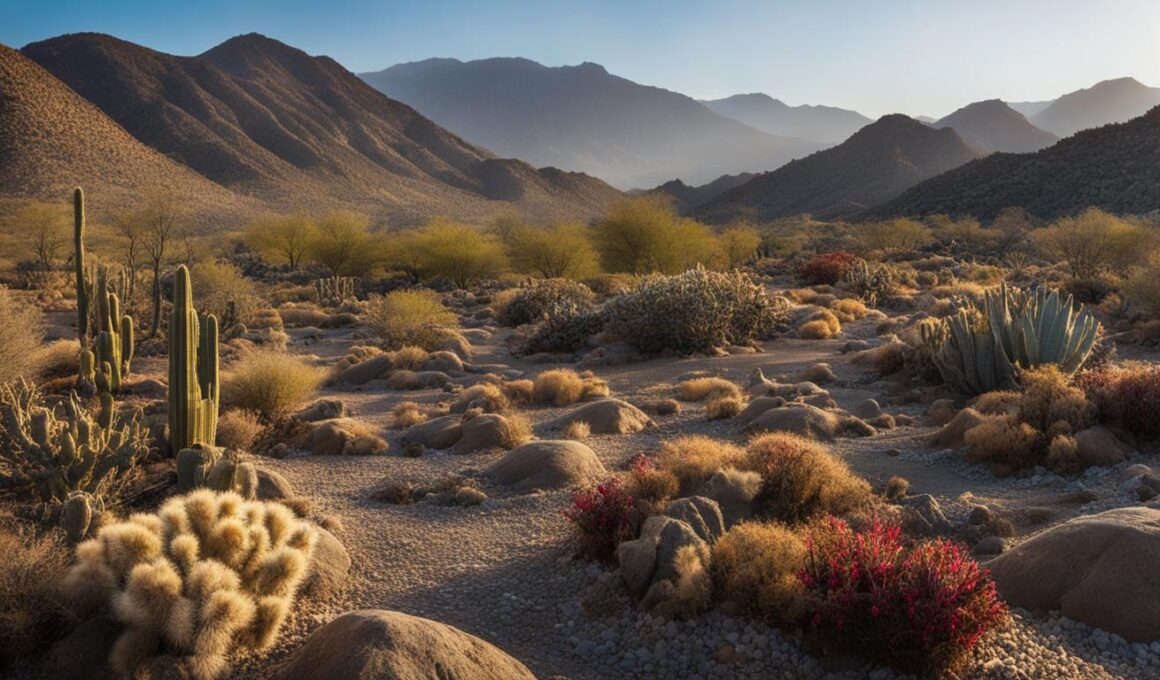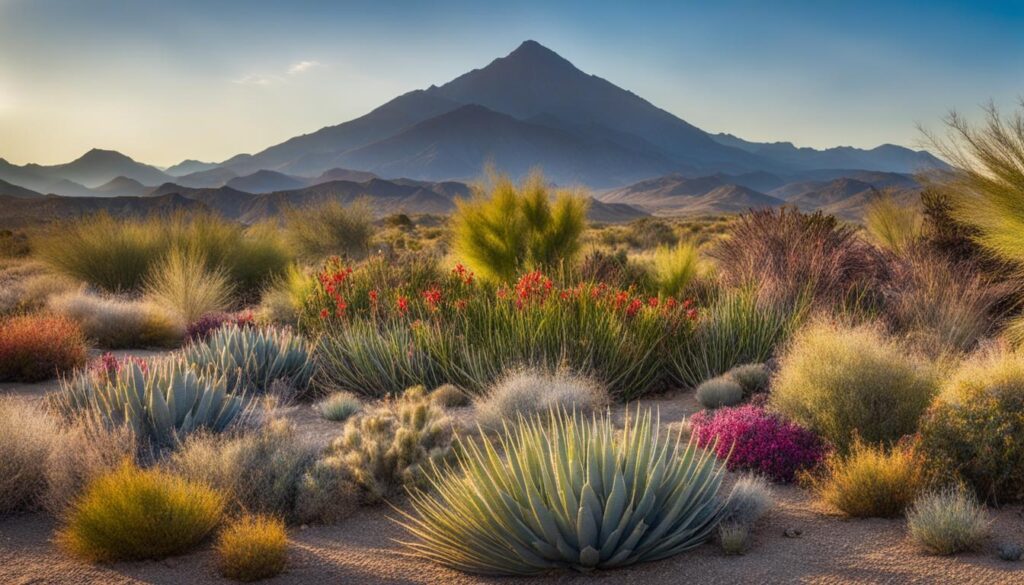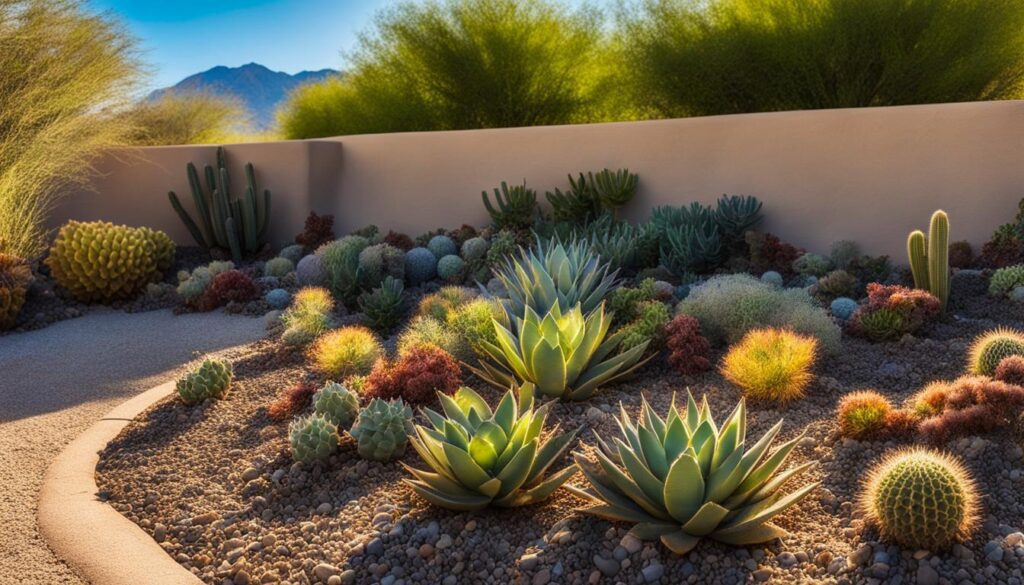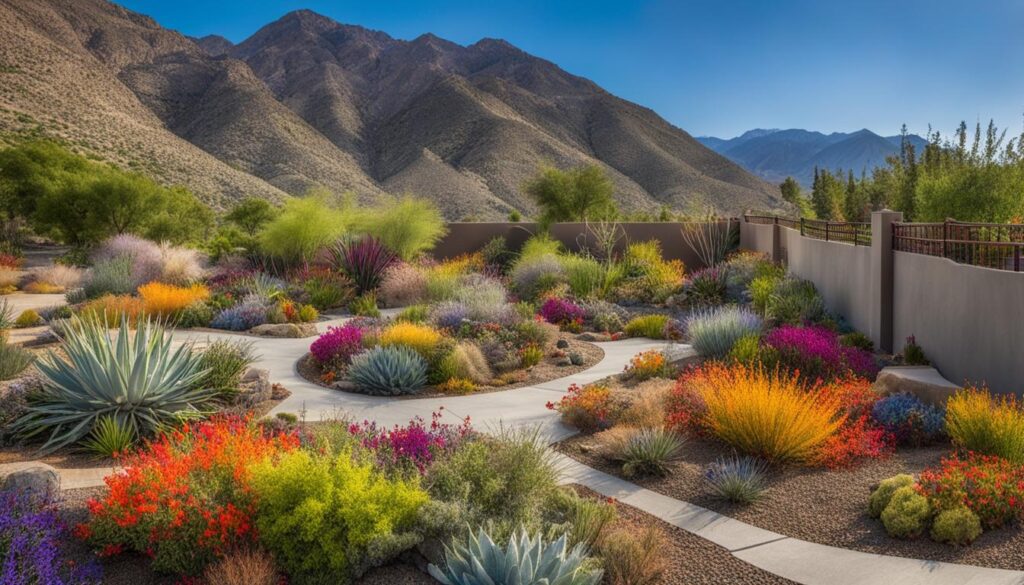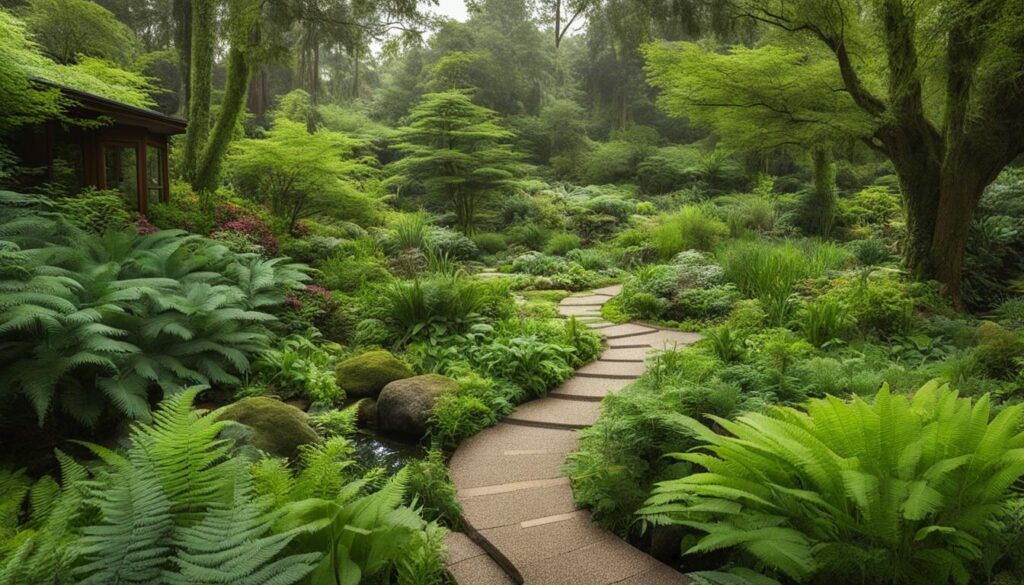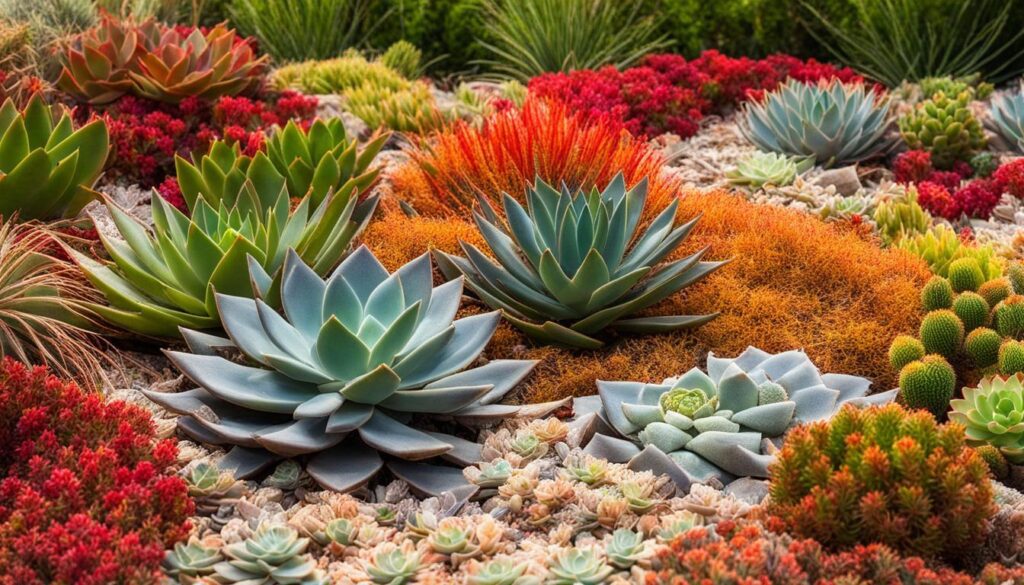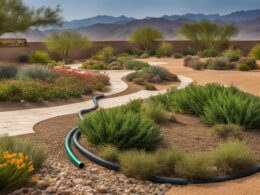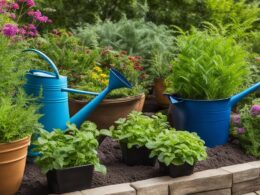Xeriscape mulching is a crucial component of creating sustainable landscapes in different climates. It not only promotes water conservation but also enhances plant health and reduces maintenance efforts. Whether you live in a dry or wet climate, implementing effective mulching techniques can make a significant difference in the success of your xeriscape design.
Key Takeaways:
- Effective xeriscape mulching plays a crucial role in water conservation and plant health.
- Choosing the right mulch, such as organic materials or rocks, can help retain soil moisture and prevent weed growth.
- Native and climate-adapted plants are essential for water efficiency and thriving in different climates.
- Proper mulching and plant selection can lead to lower maintenance needs in xeriscaped gardens.
- Xeriscape mulching can be a cost-effective landscaping option in the long run.
What is Xeriscaping and How to Start
Xeriscaping is a landscaping method that focuses on maximizing water efficiency in outdoor spaces. By implementing xeriscaping techniques, you can create a beautiful and sustainable landscape while conserving water. If you’re considering embarking on a xeriscaping project, it’s essential to understand the process and how to get started.
Working with a Landscape Designer
Before diving into xeriscaping, it’s beneficial to consult with a professional landscape designer. They can help assess your yard’s unique characteristics, such as light and shade patterns, heat and wind exposure, and natural elements like slope or trees. A landscape designer will also help you determine the soil type in your yard, which is crucial for understanding the watering needs of your plants. By collaborating with a landscape designer, you can create a customized xeriscaping plan tailored to your specific climate and soil conditions.
Evaluating Your Lawn and Plant Selection
Xeriscaping involves rethinking traditional lawns and opting for water-efficient alternatives. Assess your lawn’s size and consider reducing its area to conserve water. Limiting the size of lawns can significantly reduce water usage in your landscape design. Additionally, choose water-efficient plants for your xeriscaped garden. Native plants that are well-adapted to your climate require less water and maintenance. These plants have evolved to thrive in your specific region and are better equipped to withstand local weather conditions.
Efficient Irrigation and Watering Techniques
Efficient irrigation is a critical aspect of xeriscaping and water conservation. Consider installing drip irrigation systems, which deliver water directly to plant roots, minimizing water loss through evaporation. Grouping plants with similar watering needs together allows you to provide targeted irrigation. This approach helps avoid overwatering or underwatering specific areas, ensuring optimal plant health. Additionally, capturing and utilizing rainwater or other sources of precipitation can further reduce water consumption in your xeriscaped garden.
Limiting Water-Wasting Features
When designing a xeriscaped landscape, it’s essential to minimize water-wasting features. Avoid incorporating elements like fountains or large water features that require constant water replenishment. Instead, focus on incorporating hardscaping elements, such as paths, rocks, or gravel, which require minimal maintenance and water usage. By limiting water-wasting features, you can achieve a sustainable and water-efficient xeriscaping design.
Plant Selection and Water Efficiency
Choosing the right plants is essential for water efficiency in xeriscaping. By selecting water-efficient plants, you can greatly reduce the amount of water needed to maintain your landscape. Native plants are a top choice as they are naturally adapted to the local climate and require minimal irrigation. These plants have evolved to thrive in specific regions and have developed efficient water-use strategies.
The Benefits of Native Plants
Native plants are well-suited to the local environment, making them a low-maintenance and water-saving option. They have adapted to the climate, soil conditions, and rainfall patterns of an area. This means they require less frequent watering and are more resistant to pests and diseases. Additionally, native plants provide habitat and food for local wildlife, supporting biodiversity in your garden.
Climate-Adapted Plants
In addition to native plants, consider incorporating climate-adapted plants into your xeriscaping design. These plants come from regions with similar climates to your own and have proven to be resilient and water efficient. They may not be native to your specific area but can thrive under similar conditions. Research and consult with local nurseries or agricultural extension offices to find the best climate-adapted plants for your region.
Grouping and Efficient Irrigation
To maximize water efficiency, group plants with similar light and watering requirements together. This allows you to tailor your irrigation system to specific areas and minimize water waste. Implementing efficient irrigation methods such as drip irrigation or using smart irrigation controllers can further optimize water usage. It is important to regularly monitor soil moisture levels and adjust watering accordingly to avoid overwatering or underwatering your plants.
| Water-Efficient Plant | Watering Requirements | Additional Benefits |
|---|---|---|
| Yarrow (Achillea millefolium) | Low to moderate | Drought-tolerant, attracts pollinators |
| Penstemon (Penstemon spp.) | Low | Attracts hummingbirds, adds color |
| California Poppy (Eschscholzia californica) | Low | Drought-tolerant, self-seeds |
| Red Yucca (Hesperaloe parviflora) | Low | Drought-tolerant, architectural foliage |
By carefully selecting water-efficient plants and implementing efficient irrigation practices, you can create a beautiful and sustainable xeriscaped landscape. These choices not only conserve water but also contribute to the overall health and resilience of your garden, reducing the need for excessive maintenance.
Importance of Mulching in Xeriscaping
Mulching is a vital component of xeriscaping as it serves multiple purposes in creating a sustainable and water-efficient landscape. It plays a crucial role in preserving soil moisture, preventing weed growth, and providing insulation to plants. Whether you choose organic mulches or rock/gravel, mulching is an essential practice that can enhance the success of your xeriscaped garden.
The Benefits of Mulching
Mulching helps retain soil moisture by reducing water evaporation, especially in hot and dry climates. It acts as a protective layer on the soil surface, preventing direct exposure to the sun and minimizing water loss through evapotranspiration. By conserving moisture, mulch reduces the need for frequent irrigation, making it an efficient water-saving technique.
In addition to moisture retention, mulching provides weed prevention by blocking sunlight and hindering weed seed germination. This ensures that your plants receive adequate nutrients and water without competing with unwanted vegetation. By suppressing weed growth, mulch also reduces the need for manual weeding, saving time and effort in maintaining your xeriscaped garden.
Choosing the Right Mulch
When selecting mulch for xeriscaping, you have various options to suit your preferences and local conditions. Organic mulches, such as bark, wood chips, or straw, are popular choices as they break down over time, enriching the soil with organic matter. For shaded areas, rock or gravel mulch can be used, providing a low-maintenance and aesthetically pleasing alternative.
It’s important to consider the characteristics of your plants and climate when choosing mulch. For example, organic mulches are beneficial for plants that prefer slightly acidic soil conditions, while rock or gravel mulch can be ideal for succulents or plants that require well-drained soil. By understanding the needs of your plants, you can select the most suitable mulch for optimal growth and water conservation.
| Mulch Type | Benefits | Considerations |
|---|---|---|
| Organic Mulch | Retains moisture, prevents weeds, adds organic matter to the soil | Requires periodic replacement, can attract pests if not properly managed |
| Rock/Gravel Mulch | Low maintenance, improves drainage, long-lasting | Not suitable for all plants, may increase soil temperature in hot climates |
Remember to apply mulch properly to maximize its benefits. Apply a layer of mulch around 2-4 inches thick, ensuring that it doesn’t pile up against the stems or trunks of plants. This allows for proper air circulation and prevents potential rot or pest infestations. Regularly monitor the mulch layer and replenish it as needed to maintain its effectiveness in conserving soil moisture and suppressing weed growth.
By understanding the importance of mulching in xeriscaping, you can create a resilient and sustainable landscape that conserves water while promoting the health of your plants. Implementing mulching practices not only reduces maintenance efforts but also contributes to the overall beauty and longevity of your xeriscaped garden.
Lower Maintenance in Xeriscaped Gardens
Xeriscaped gardens are known for their low maintenance requirements, making them an ideal choice for homeowners who want to spend less time and effort on landscaping tasks. By following a few core principles and intentional planning, you can create a beautiful and sustainable outdoor space that requires minimal upkeep.
Core Principles of Xeriscaping
To achieve lower maintenance in xeriscaped gardens, it’s essential to understand and follow the core principles of xeriscaping:
- Proper Planning: Before starting your xeriscaping project, take the time to plan carefully. Consider the size and layout of your yard, the climate and weather conditions in your area, and the specific needs of your chosen plants.
- Water-Efficient Plant Selection: Choose plants that are well-suited to your local climate and require minimal watering. Native plants and climate-adapted species are excellent choices as they are naturally adapted to thrive in their specific environments.
- Efficient Irrigation: Implementing efficient irrigation systems, such as drip irrigation or smart irrigation controllers, can significantly reduce water waste and the need for constant monitoring and adjustment.
- Mulching: Mulching plays a vital role in xeriscaping by conserving soil moisture, insulating plants, and preventing weed growth. Choose organic mulches like bark or wood chips that decompose over time and provide additional nutrients to the soil.
By incorporating these core principles into your xeriscaping project, you can create a landscape that requires less time and effort to maintain while still enjoying its beauty and environmental benefits.
Designing with Intention for Lower Maintenance
Intentional planning is key to achieving lower maintenance in xeriscaped gardens. Consider the following tips when designing your landscape:
- Use groupings: Group plants with similar water and sunlight needs together. This not only simplifies watering but also reduces the risk of overwatering or underwatering certain plants.
- Minimize turf areas: Limiting the size of your lawn or eliminating it altogether can significantly reduce maintenance requirements. Replace turf with low-water groundcovers, perennial beds, or hardscaping features.
- Choose low-maintenance plants: Select plants that are known for their resilience, disease resistance, and minimal pruning requirements. This will help reduce the amount of time and effort needed to keep your garden looking its best.
- Create functional spaces: Design your xeriscaped garden to include functional spaces, such as seating areas or outdoor kitchens. This way, you can spend more time enjoying your garden rather than working on its upkeep.
By incorporating these intentional design practices and following the core principles of xeriscaping, you can create a lower maintenance xeriscaped garden that thrives with minimal effort, allowing you to spend more time enjoying the beauty of your outdoor space.
Xeriscaping in Different Climates
While xeriscaping is commonly associated with arid climates, it can also be successfully implemented in wetter regions. By adapting the principles of xeriscaping, homeowners in these climates can create beautiful and water-efficient landscapes that thrive in their unique environment. Incorporating the right plants, such as ferns and shrubs suited to temperate conditions, and utilizing materials that aid moisture retention can help achieve the desired results.
To create an Alpine look in wetter climates, gravel, pink bark mulch, or rocks can be used to retain moisture and add visual interest. These materials not only enhance water retention but also create texture and depth in the landscape. By carefully selecting plants and materials that support moisture retention, you can create a xeriscape that thrives in wetter conditions while still conserving water.
Implementing a variety of moisture retention techniques can further enhance the success of xeriscaping in wetter climates. These techniques may include capturing and utilizing rainwater runoff, implementing drip irrigation systems, and designing the landscape to maximize water infiltration. By combining these strategies with climate-appropriate plant selection, you can create a xeriscape that not only conserves water but also thrives in a wetter climate.
Table: Moisture Retention Materials for Xeriscaping in Wetter Climates
| Material | Description | Benefits |
|---|---|---|
| Gravel | An inorganic material that aids in water drainage and retention. | Enhances water infiltration, creates visual interest, and helps prevent erosion. |
| Pink Bark Mulch | An organic mulch made from shredded bark that helps retain moisture in the soil. | Improves water retention, suppresses weed growth, and adds aesthetic appeal. |
| Rocks | Inorganic materials that can be strategically placed to retain moisture and add texture to the landscape. | Enhances water retention, creates visual interest, and requires minimal maintenance. |
By understanding the unique challenges and opportunities of xeriscaping in wetter climates, you can create a sustainable and visually appealing landscape that conserves water and thrives in its environment. Whether you’re dealing with heavy rainfall or high humidity, implementing the principles of xeriscaping and choosing plants and materials that support moisture retention will help you achieve an efficient and beautiful landscape.
Xeriscaping on a Budget
Xeriscaping is an excellent landscaping option for homeowners who want to create beautiful outdoor spaces while conserving water and minimizing maintenance. While it may seem expensive at first, implementing xeriscaping techniques can actually be cost-effective in the long run. By making strategic choices and utilizing budget-friendly materials, you can create a stunning xeriscape design without breaking the bank.
One cost-effective option for xeriscaping is using gravel as a ground cover. Gravel not only adds texture and visual interest to your landscape but also helps retain moisture in the soil. Additionally, gravel requires little to no maintenance and can be easily incorporated into various design styles. By opting for gravel instead of more expensive materials, you can significantly reduce installation costs while still achieving a stylish and water-efficient landscape.
When selecting plants for your xeriscape, consider using locally sourced or native plants. These types of plants are well-adapted to the local climate and require less water and maintenance. Native plants are also typically more affordable than exotic or non-local species. By choosing plants that are naturally suited to your area, you can save money on irrigation and ensure the long-term success of your xeriscape.
| Material | Cost per Square Foot |
|---|---|
| Gravel | $0.50 – $2.00 |
| Drought-tolerant plants | $3.00 – $10.00 |
| Organic mulch | $1.50 – $3.00 |
| Irrigation system | $0.75 – $2.00 per square foot |
By making strategic choices and utilizing budget-friendly materials, you can create a stunning xeriscape design without breaking the bank.
Incorporating recycled or salvaged materials in your xeriscape can also help reduce costs. Consider using reclaimed wood for raised beds or pathways, or repurposing old containers as planters. Not only will this save you money, but it will also give your xeriscape a unique and eco-friendly touch.
Xeriscaping on a budget is not only achievable but can also lead to significant long-term savings. By implementing cost-effective strategies, such as using gravel, selecting native plants, and incorporating recycled materials, you can create a beautiful and water-efficient landscape that fits your budget.
How Does Xeriscape Mulching Differ Based on Different Climates in the US?
Xeriscape ground cover options vary greatly depending on the climate in the US. In arid regions, mulching with desert-adapted plants like succulents and gravel is common. In more temperate areas, organic mulches such as wood chips or bark are used to retain moisture and suppress weeds while creating an attractive landscape.
Conclusion
Xeriscape mulching is a crucial component in creating beautiful and sustainable outdoor spaces that promote water conservation and require low maintenance in different climates. By following the principles of xeriscaping, you can achieve a landscape that is not only visually appealing but also environmentally friendly.
Intentional planning is key in xeriscaping, allowing you to maximize the benefits of water conservation and low maintenance. Selecting water-efficient plants adapted to your climate ensures that your landscape thrives while minimizing water usage. Implementing efficient irrigation systems further enhances water conservation efforts.
One of the most important aspects of xeriscaping is proper mulching. Xeriscape mulching helps retain soil moisture, insulate plants, and prevent weed growth, reducing the need for frequent watering and weed control. Whether you choose organic mulches like bark or wood grindings, or opt for rock or gravel, mulching plays a vital role in the success of your xeriscape.
By embracing xeriscape mulching techniques, you can enjoy a beautiful, low-maintenance landscape that conserves water and adapts to different climates. Xeriscape mulching is not only beneficial for the environment but also for your wallet, as it reduces water usage and maintenance efforts in the long run. So start xeriscaping today and create a sustainable outdoor space that you can enjoy for years to come.





